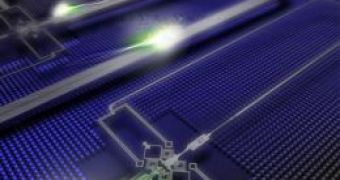This is a huge step towards the ultra-powerful quantum computers of the future: a team at the National Institute of Standards and Technology has transmitted information between two "artificial atoms" through electronic vibrations on a microfabricated aluminum cable, like a miniversion of a TV cable, but with powerful added traits, like superconducting circuits with zero electrical resistance and quantum multi-tasking data bits.
The resonant cable could be part of quantum computers, which would be based on quantum physics to accomplish several functions, like code-breaking and database searches, much faster than most powerful computers, optimized complex systems like airline schedules, counterfeit-proof money and solve complex mathematical problems. The new superconducting components are also easier to make at a practical size than many similar candidates, like individual atoms, for storing and carrying data in quantum computers.
While current chips store data in digital bits, each being either 0 or 1, each superconducting circuit has the function of a quantum bit (qubit), which can have values of 0 and 1 at the same time, permitting many more calculations to be made simultaneously than allowed by digital bits, so that they could lead to faster and more powerful computers.
Cable's resonant section transporting the data between the two superconducting circuits is called "quantum bus". A quantum bus can carry information between two or more qubits. Data was encoded in one qubit, transmitted as microwave energy to cable's resonant section for a storage time of 10 nanoseconds and then successfully passed to a second qubit. This is crucial when performing the main functions in a quantum computer.
"We tested a new element for quantum information systems. It's really significant because it means we can couple more qubits together and transfer information between them easily using one simple element." said NIST physicist Ray Simmonds. Recently, a Yale team made a quantum bus to induce an interaction of two qubits, resulting in a combined superposition state. NIST's resonant cable can also "refresh" superconducting qubits, which usually can keep the same quantum state for just 0.5 microseconds. Slight disturbances like electric or magnetic noise in the circuit can quickly impair a qubit's superposition state.
"With design improvements, the NIST technology might be used to repeatedly refresh the data and extend qubit lifetime more than 100-fold, sufficient to create a viable short-term quantum computer memory. NIST's resonant cable might also be used to transfer quantum information between matter and light -- microwave energy is a low-frequency form of light -- and thus link quantum computers to ultra-secure quantum communications systems." said Simmonds.
A qubit has the width of a human hair and the NIST team makes two qubits on a sapphire microchip, located in a shielded box of 8 cubic mm. The resonant section of cable is 7 mm long, like the coaxial wiring employed in TV cable but much thinner and flatter, zig-zagging around the 1.1 mm area between the two qubits. Like a string, the cable can be activated to resonate at a particular tone or frequency in the microwave range. Quantum data is stored as energy of microwave particles (including photons).

 14 DAY TRIAL //
14 DAY TRIAL //